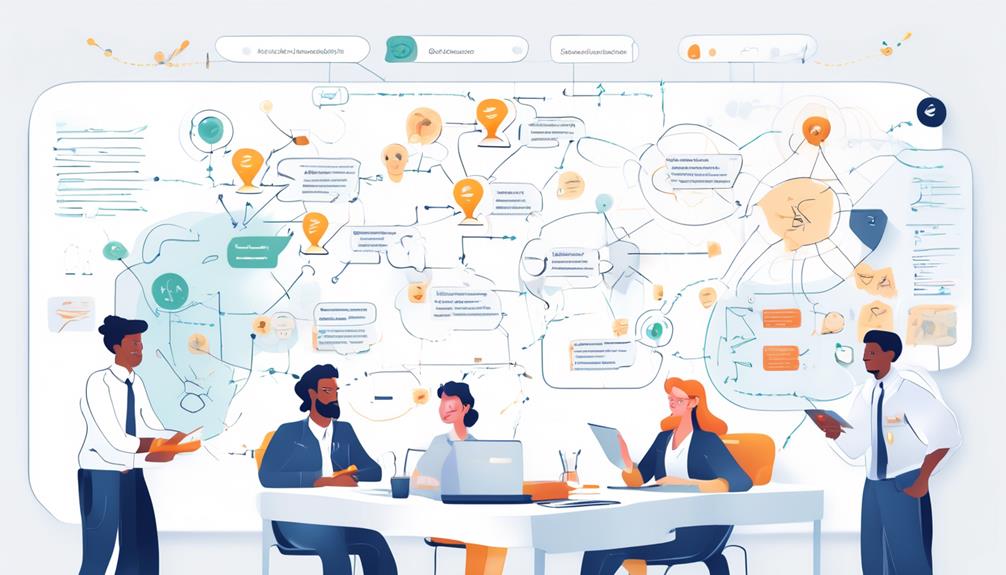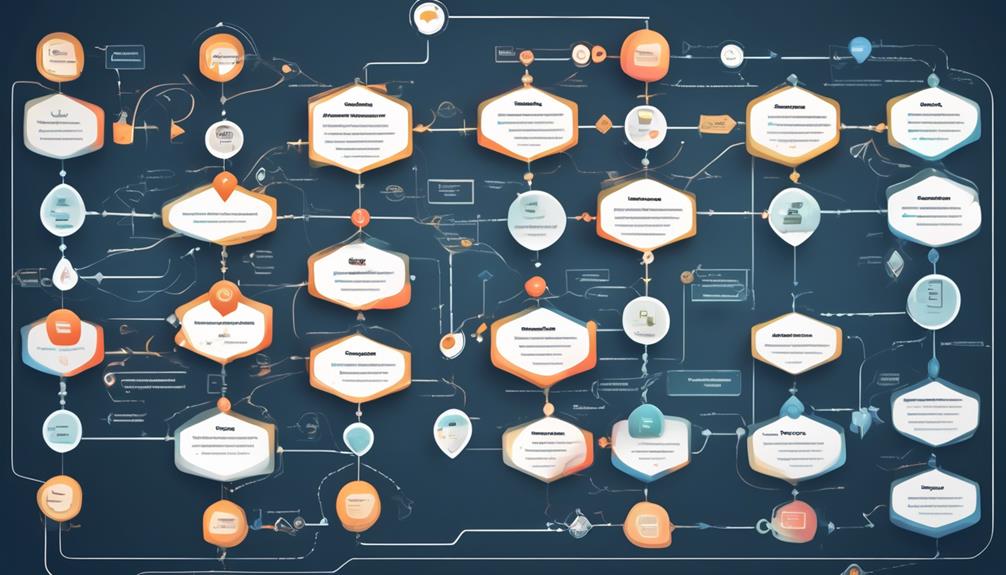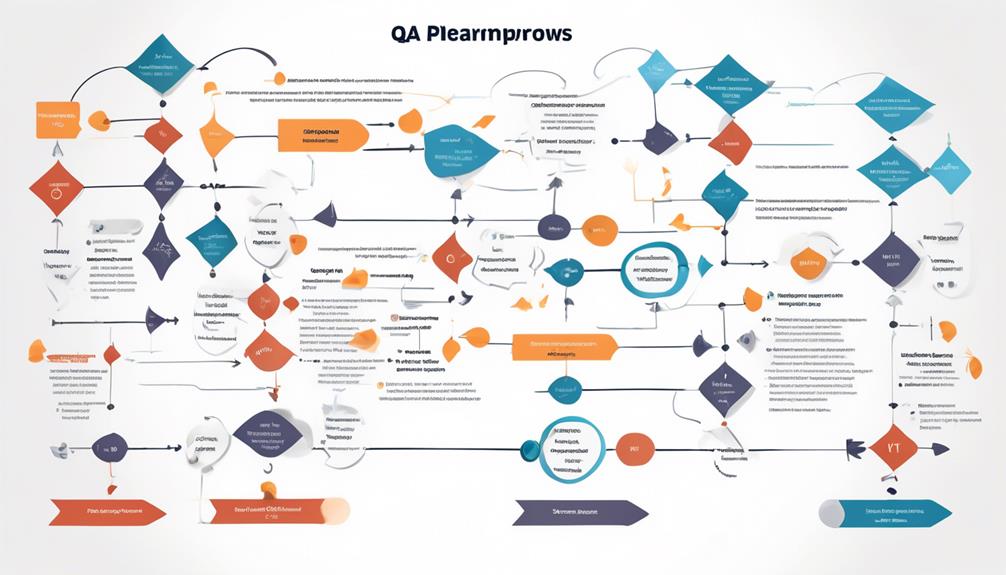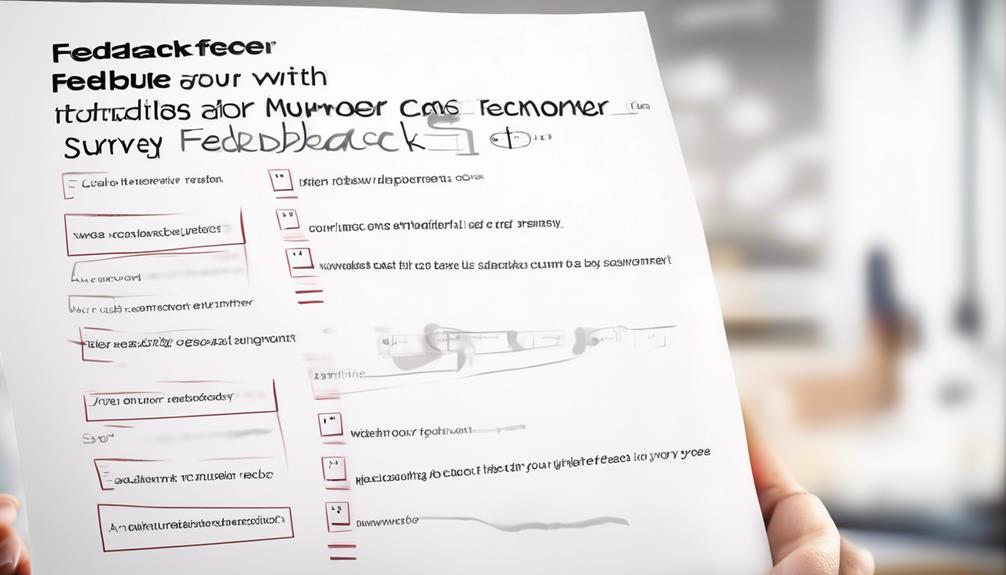Process Enhancement
What Elevates Your QA Process Efficiency?
Leverage the key factors that contribute to a more efficient QA process and drive better outcomes for your teams and products.

In our pursuit to improve the effectiveness of our QA procedures, we constantly seek the best strategies to refine our testing approaches.
There’s a constant drive to optimize our workflows and improve productivity.
But what really makes a difference? How can we ensure that our QA process is running at its peak efficiency?
Let’s explore the key factors that contribute to a more efficient QA process and how they can be implemented to drive better outcomes for our teams and products.
Key Takeaways
- Refine testing methodologies and establish clear objectives to optimize the QA process
- Clarify and document requirements, verifying and validating with stakeholders for effective QA
- Adhere to coding standards, incorporate developer testing, and use checklists for quality code production
- Ensure the right testing environments are set up, pay attention to details, and regularly review test coverage for efficient QA process.
Understanding QA Process Optimization
To effectively optimize the QA process, we must proactively examine and refine our testing methodologies to ensure maximum efficiency and effectiveness throughout the software development lifecycle.
Establishing clear objectives is fundamental to aligning with organizational trajectory and communicating the importance of the QA process.
By implementing communication and reporting practices, we can ensure effective collaboration between stakeholders and establish clear bug reporting channels, thereby enhancing the overall quality of the software.
Emphasizing shift-left testing is crucial as it involves QA teams from project inception, allowing for early identification and resolution of potential issues.
Additionally, automating repetitive tasks not only optimizes costs but also accelerates the QA cycle, leading to a more efficient process.
Test planning strategies play a pivotal role in process improvement, and creating test planning guidelines and defining success metrics for various testing types are essential steps in this regard.
Continuous monitoring, auditing, and improvement of the QA process are imperative, and leveraging tools like TestRail, Selenium, Gatling, Jira, and Sonarqube is instrumental in enhancing software quality.
Clarifying Requirements for QA

Ensuring clear and comprehensive documentation of both functional and non-functional requirements is crucial for establishing a strong foundation in the QA process. Clarifying requirements not only enhances efficiency but also serves as a cornerstone for QA improvement. By clearly defining and documenting requirements, the testing processes become more focused and effective. Establishing a process for verifying and validating requirements with stakeholders is essential to ensure mutual understanding. Visual aids such as flowcharts, wireframes, and mockups further enhance requirement clarity and minimize misinterpretation. Encouraging open communication channels between the QA team, developers, and project stakeholders helps address any requirement ambiguities or inconsistencies. Regularly reviewing and updating the documented requirements is imperative to accommodate changes in the project scope or stakeholder needs.
Key Actions for Clarifying Requirements Benefits Define and document requirements Enhanced efficiency Verify and validate with stakeholders Mutual understanding Use visual aids for clarity Minimize misinterpretation
These key actions lead to a more robust QA process, ultimately improving the overall quality of the product or service.
Ensuring Quality Code Production
We prioritize quality code production by strictly adhering to coding standards and best practices. This ensures that our code is consistent, maintainable, and easily understandable.
Incorporating developer testing as an integral part of our QA process allows us to identify and resolve issues early on. Developer testing catches bugs and issues at an early stage, reducing the need for extensive debugging later in the QA process.
We also use checklists to remind developers of necessary steps and ensure comprehensive testing coverage.
Setting up the right environments for accurate and efficient testing is crucial to avoid inconsistencies that could lead to undetected bugs.
Clear and well-defined requirements are essential to avoid significant issues and ensure that the software aligns with customer expectations.
This approach not only improves our QA process but also contributes to the overall efficiency and quality assurance of our software testing efforts.
Setting Up QA Environments

Transitioning from prioritizing quality code production, we now focus on the crucial aspect of setting up QA environments to ensure accurate testing and efficient quality assurance.
Setting up QA environments involves ensuring that the right testing environments are in place to meet the specific needs of the QA team, technology stack, and tools used. It’s essential to consider the requirements of the QA process and implement developer testing as part of the process.
Checklists can be used to remind developers of necessary steps and to clarify requirements, thus avoiding significant issues during the testing phase.
By setting up QA environments effectively, the QA team can streamline the testing and improving QA process, leading to higher efficiency and better outcomes. This proactive approach to setting up QA environments not only ensures accurate testing but also contributes to the overall quality of the software being developed.
Therefore, it’s crucial to pay close attention to the details and intricacies involved in setting up QA environments to elevate the efficiency of the QA process.
Reviewing Test Coverage Regularly
Regularly reviewing and updating test cases is essential to ensure comprehensive test coverage and to overcome the pesticide paradox. By identifying gaps and adding new test cases, we can improve test coverage and the efficiency of our QA process. It’s crucial to define a schedule for test case review sessions to ensure consistent monitoring and alignment with evolving product features and requirements.
Utilizing test coverage reports can help us identify areas that need additional testing attention, further enhancing the effectiveness of our QA process.
Reviewing test coverage regularly allows us to stay proactive in our approach, ensuring that our testing efforts are always aligned with the most current state of the product. This proactive stance enables us to catch potential issues early, reducing the likelihood of critical bugs slipping through to production.
Additionally, a comprehensive test coverage review process fosters a culture of continuous improvement, driving efficiency gains in our QA process over time. With this approach, we can confidently deliver high-quality products while maximizing our testing resources.
Defining QA for Your Team

We need to ensure that our team has a clear understanding of QA and its importance in the development process.
By defining clear expectations for QA, we can ensure that everyone is aligned and working towards the same goals.
This will help us to streamline our processes and improve overall efficiency.
Team Understanding QA
To ensure a successful understanding of QA within the team, it is crucial for developers and product managers to recognize the pivotal role it plays in software development. Quality assurance (QA) is not just a separate process; it is an integral part of the entire software development lifecycle. By involving a cross-section of the team in QA throughout the build process, everyone gains a deeper understanding of its importance. Clear guidelines and expectations for the development team regarding QA should be established to ensure a unified approach. Highlighting the benefits of QA, such as reducing costs and improving software quality, can further emphasize its significance. The development lead or product owner should take responsibility for ensuring that QA takes place, fostering a culture where the entire team understands and values the QA process.
Key Points Description Importance Integral Part of SDLC QA is not a separate process but an essential part of development Ensures software quality and customer satisfaction Clear Guidelines Establishing clear expectations for the development team Ensures a unified and structured approach Highlighting Benefits Emphasizing the advantages of QA Encourages team buy-in and commitment
Clear QA Expectations
An effective approach to defining QA for your team involves clearly communicating the importance of quality assurance to both developers and product managers. By setting clear QA expectations, you can ensure that the entire team understands the significance of QA in the development process.
Here’s how to achieve this:
- Ensure that the development lead or product owner takes responsibility for ensuring QA processes are in place.
- Establish clear guidelines and expectations for the development team regarding QA.
- Highlight the benefits of QA, including cost reduction and improved software quality.
- Involve a cross-section of your team in QA throughout the build process.
Analyzing Software Requirements

Analyzing the software requirements is a critical step in understanding the needs and expectations of the end users, ensuring that the developed software aligns with their objectives and delivers value. It involves studying and interpreting the functional and non-functional requirements of the software or application.
By identifying and documenting software requirements, a clear roadmap for development and testing activities is created. This not only aids in the development process but also in QA process improvement.
Analyzing software requirements helps in identifying potential areas for improvement and detecting any inconsistencies or gaps in the requirements. It plays a crucial role in ensuring that the developed software aligns with the business objectives and delivers value to the end users.
Additionally, this process facilitates proactive problem-solving by addressing any issues or discrepancies in the early stages of the software development lifecycle.
Ultimately, thorough analysis of software requirements serves as the foundation for a successful software development and testing process, leading to higher efficiency and quality in the final product.
Analyzing Current QA Process

As we analyze our current QA process, we’ll focus on process analysis, efficiency assessment, and improving our QA methods.
We aim to identify areas where our process can be streamlined and made more efficient, ultimately leading to improved product quality.
Process Analysis
To gain insight into the effectiveness of our current QA process, we’ll conduct a comprehensive analysis of its various components and procedures. This process analysis is essential for identifying areas of improvement and enhancing the overall efficiency of our QA process.
Here are the key steps we’ll take:
- Analyze software requirements to ensure alignment with the QA process objectives.
- Evaluate the existing QA process to pinpoint inefficiencies and opportunities for enhancement.
- Employ effective tools such as TestRail, Selenium, Gatling, Jira, and Sonarqube to streamline the QA process.
- Consider factors affecting QA process improvement costs to make informed decisions and optimize resource allocation.
Efficiency Assessment
After thoroughly examining the components and procedures of our current QA process in the previous subtopic, it’s now imperative to assess its efficiency to identify opportunities for enhancement and optimization.
Efficiency assessment involves evaluating the effectiveness of our QA process, analyzing the workflow, tools, and methodologies in use, and reviewing performance metrics and KPIs.
By identifying bottlenecks, inefficiencies, and areas for improvement, we can develop a comprehensive plan to streamline and optimize the QA process.
This assessment allows us to pinpoint areas where improvements can be made to enhance the overall efficiency of our quality assurance efforts.
It’s crucial to continuously assess and improve your QA process to ensure that it aligns with industry best practices and meets the evolving needs of your organization.
Improving QA Methods
We regularly analyze our existing QA process to pinpoint areas for improvement and ensure optimal efficiency. Our focus on improvement involves the following key steps:
- Establishing Clear Objectives: We set clear objectives and communication practices to ensure an effective QA process that aligns with our overall quality assurance goals.
- Implementing Shift-Left Testing and Test Automation: We prioritize shift-left testing and test automation to enhance efficiency and identify defects at early stages of development.
- Developing Test Planning Strategies: We develop comprehensive test planning strategies to streamline our QA process and maximize the utilization of testing tools for improvement.
- Continuous Learning and Improvement: We emphasize the use of QA metrics and KPIs to continuously learn and improve our QA methods, ensuring ongoing enhancement and optimization.
Preparing QA Process Improvement Plan

In order to achieve a more efficient QA process, we will devise a comprehensive improvement plan that addresses key areas of optimization and streamlining. Our approach to testing will involve defining clear objectives aligned with organizational goals and emphasizing the importance of the QA process to all stakeholders. Effective communication and reporting practices will be established to ensure transparency and streamline bug reporting and issue resolution. We will also implement shift-left testing to involve QA teams from project inception and automate repetitive tasks to optimize costs and improve efficiency.
To grab the attention of our audience, here’s a table outlining the key components of our QA process improvement plan:
Key Areas of Improvement Action Steps Clear Objectives Alignment Communicate goals, importance of QA process Effective Communication Establish transparent reporting practices Shift-Left Testing Involve QA teams from project inception, automate repetitive tasks
We will also focus on developing test planning strategies to create guidelines, define success metrics, and engage in comprehensive testing across different aspects of the project. Continuous measurement, updates, knowledge transfers, and feedback will be implemented to monitor and improve the QA process using tools like TestRail, Selenium, Gatling, Jira, and Sonarqube.
Implementing and Monitoring QA Improvements

Upon analyzing our current QA process and identifying areas for improvement, we’ll now focus on implementing and monitoring the QA improvements to enhance overall efficiency and effectiveness.
The following steps are crucial for successful quality assurance process improvement:
- Establish Clear Objectives: Clearly define the goals and objectives of the QA improvements and communicate them effectively to all stakeholders involved in the QA process. This ensures alignment and understanding across the team, fostering a unified effort towards improvement.
- Implement Shift-Left Testing: Involve QA teams from the beginning of the software development lifecycle to identify and address potential issues early on, reducing the likelihood of major defects later in the process.
- Automate Repetitive Tasks: Optimize efficiency and reduce manual efforts by automating repetitive tasks within the QA process. This allows resources to be reallocated to more strategic and impactful testing activities.
- Monitor and Evaluate: Regularly monitor and evaluate the implemented improvements to ensure their effectiveness. This includes tracking key performance indicators, gathering feedback, and making necessary adjustments to maintain a robust QA process.
Establishing Communication and Reporting

Communication channels and reporting protocols should be established to facilitate effective collaboration and issue resolution between developers and QA testers. By outlining clear documentation and communication channels, the QA process efficiency can be significantly improved.
Standardizing reporting formats ensures that information is conveyed in a clear and consistent manner, reducing the likelihood of misunderstandings. This also enables team members to easily comprehend and act upon the information provided.
Effective communication between developers and QA testers is crucial for efficient issue resolution, and establishing clear channels for reporting bugs and issues streamlines the entire problem-solving process. Additionally, by ensuring that all stakeholders have opportunities to initiate contact and contribute to the communication flow, the overall efficiency of the QA process can be enhanced.
It’s essential for the QA manager to take a proactive approach in enabling and overseeing these communication and reporting processes, as they play a pivotal role in the successful execution of QA activities.
Shifting Left in QA

Shifting Left in QA involves integrating QA teams into the software development process from the outset, allowing for early testing and proactive issue resolution. This approach emphasizes collaboration and decision-making involvement of QA teams to identify and resolve issues promptly. By implementing shift-left testing, costs can be reduced, and a smooth project pipeline can be maintained. Automation of repetitive tasks through tools reduces manual labor and optimizes costs.
Additionally, developing test planning strategies to define success metrics for regression testing, performance testing, security testing, and usability testing is essential.
- Early Integration: Involving QA teams from project inception enables early testing in the software development lifecycle, leading to proactive issue resolution.
- Cost Reduction: Implementing shift-left testing can lower costs and maintain a smooth project pipeline.
- Automation: Test automation reduces manual labor, optimizes costs, and allows for efficient testing processes.
- Comprehensive Test Planning: Developing test planning strategies defines success metrics for various types of testing, ensuring thorough assurance (QA) throughout the software development lifecycle.
Automating Testing Processes

Let’s consider the critical aspects of tool selection and script maintenance when it comes to automating testing processes.
Efficient tool selection is paramount in ensuring that the chosen automated testing tools align with the specific needs and requirements of the QA process.
Additionally, proactive script maintenance is essential for sustaining the long-term effectiveness and reliability of the automated testing framework.
Tool Selection
To improve the efficiency of the QA process, careful consideration must be given to the selection of automation tools for testing processes. When choosing automation tools, several best practices should be considered:
- Project Complexity: Evaluate the complexity of projects and end users to determine the most suitable automation tools.
- Technology Stack: Consider the technology stack to ensure compatibility and seamless integration with existing systems.
- Cost Evaluation: Assess the cost of QA process improvement, including licensing, training, and implementation costs.
- Task Automation: Select tools that can automate repetitive tasks, increase test coverage, and expedite the QA cycle.
Script Maintenance
Automating testing processes through script maintenance is a crucial aspect of improving QA process efficiency, ensuring consistent and reliable test execution while saving time and effort. QA teams must prioritize regular updates and maintenance of test scripts to guarantee accurate and effective automated testing.
This proactive approach not only speeds up the testing process but also aids in early issue identification. By reducing the possibility of human error, automated testing processes contribute to overall testing efficiency. Effective script maintenance is essential for QA teams to leverage the full potential of automation in testing.
It’s imperative for QA teams to understand that script maintenance isn’t a one-time task but an ongoing process that significantly impacts the effectiveness of automated testing.
Developing Test Planning Strategies

Developing test planning strategies involves understanding the importance of defining success metrics for regression, usability, and performance testing and implementing clear guidelines to ensure accurate and efficient testing. To enhance QA process efficiency, our development team should consider the following strategies:
- Set baseline measures for performance and security testing to guide the test planning process. This ensures that the testing process is aligned with the expected performance and security standards, allowing for early identification and resolution of potential issues.
- Engage in security testing across all attack vectors as part of the test planning strategy. By comprehensively assessing security from various angles, potential vulnerabilities can be identified and addressed, contributing to a more robust and secure end product.
- Define a schedule for test case review sessions to enhance test planning effectiveness. Regular review sessions facilitate continuous improvement of test cases, ensuring they remain relevant and comprehensive throughout the development lifecycle.
- Implement a collaborative approach to test planning involving the development team. Involving relevant stakeholders in the test planning process ensures that different perspectives are considered, leading to a more thorough and effective test strategy.
Frequently Asked Questions
How Can We Improve QA Efficiency?
Improving QA efficiency involves optimizing processes, leveraging automation, and fostering collaboration.
We analyze current workflows, identify bottlenecks, and prioritize automation opportunities.
Our team implements test scripts, continuous integration, and deployment pipelines to streamline testing.
We proactively communicate with stakeholders to ensure alignment and gather feedback for continuous improvement.
How Can I Improve My QA Process?
Improving our QA process involves refining test strategy and optimizing test execution. We integrate automation for repetitive tasks, enhancing efficiency.
Clear communication and collaboration foster a unified approach. By incorporating feedback loops, we continuously refine our process.
Defining clear objectives and regular reviews ensure alignment with requirements. Incorporating developer testing and proactive gap identification elevates our QA process efficiency.
This visualizes our journey towards a streamlined, efficient QA process.
What’s an Example of How You Enhanced the QA Process in Your Last Job?
In our last job, we enhanced the QA process by implementing shift-left testing, involving QA teams from project inception. This reduced costs and maintained a smooth project pipeline.
Additionally, we utilized automation tools, reducing manual effort and enabling faster release cycles.
Clear communication and reporting practices were established, ensuring all stakeholders had opportunities to initiate contact.
We also developed test planning strategies, creating guidelines for QA departments and defining success metrics for various testing types.
What Is the Best Way to Make Quality Assurance Into Your Process?
To maximize quality assurance integration, we prioritize proactive planning and persistent participation. By involving QA teams from the project’s inception, we identify potential issues early.
Utilizing automation tools reduces manual effort and increases efficiency. Risk-based testing prioritization minimizes business risks.
Comprehensive documentation, defect tracking, and actionable insights ensure continuous improvement. This proactive and participative approach elevates our QA process efficiency and enhances overall product quality.
Conclusion
In conclusion, by embracing automation tools and implementing efficient testing strategies, we can revolutionize our QA process. We can dramatically reduce manual labor, increase test coverage, and accelerate the overall testing process.
With these powerful tools at our disposal, we’ve the potential to elevate our QA process efficiency to unprecedented levels, ensuring the delivery of high-quality software products and meeting the needs of our customers with precision and excellence.
Randy serves as our Software Quality Assurance Expert, bringing to the table a rich tapestry of industry experiences gathered over 15 years with various renowned tech companies. His deep understanding of the intricate aspects and the evolving challenges in SQA is unparalleled. At EarnQA, Randy’s contributions extend well beyond developing courses; he is a mentor to students and a leader of webinars, sharing valuable insights and hands-on experiences that greatly enhance our educational programs.
Process Enhancement
Elevating Your Quality Assurance With Proven Techniques
Optimize your quality assurance with proven techniques to ensure software success – find out how to revolutionize your approach.

It is widely acknowledged that a staggering 56% of software projects fail due to insufficient quality assurance procedures.
But what if I told you there are proven techniques that can elevate your QA processes and mitigate this risk?
By implementing innovative strategies and leveraging proven methodologies, organizations can significantly improve the quality and reliability of their software products.
But how exactly can this be achieved?
Stay tuned to discover the practical steps and techniques that can transform your quality assurance approach and set your organization apart in the competitive market.
Key Takeaways
- Implementing a robust QA framework is crucial for ensuring software products meet required standards and preventing defects from reaching customers.
- Fostering a culture of quality within the team and integrating quality checkpoints into every stage of development are important techniques for improving QA.
- Leveraging automation tools for testing and monitoring can greatly enhance QA effectiveness and productivity.
- Establishing an independent QA department, adequately staffing it with competent professionals, and providing continuous learning opportunities are essential pillars for exceptional QA performance.
Understanding the Importance of QA
Understanding the importance of QA is crucial for ensuring that defects are prevented from reaching customers through rigorous testing and reviews. In software development, QA plays a pivotal role in ensuring that the product meets the required standards. It provides an objective view of the software, ensuring unbiased evaluation and upholding software quality amidst competing priorities. Moreover, QA’s role in gauging readiness for release, collecting vital metrics, and instilling confidence in the software is essential for successful development.
Quality Assurance is an ongoing process that requires continuous improvement. It’s imperative to understand that common issues in conventional QA include lack of autonomy, resource constraints, and an obsession with vanity metrics. Recognizing these pitfalls allows for the implementation of strategies that address these challenges effectively.
Pillars of exceptional QA include independence, maintaining a strong focus on quality, ensuring adequate staffing, promoting continuous learning, and leveraging automation to enhance productivity and morale within the team.
Overcoming Conventional QA Flaws

To address the conventional flaws prevalent in quality assurance (QA), a proactive approach is essential for identifying and rectifying systemic issues. One of the key techniques for overcoming conventional QA flaws is to implement a robust quality assurance framework that emphasizes continuous improvement and learning from past mistakes. This involves fostering a culture of quality within the QA team and integrating quality checkpoints into every stage of the product development lifecycle. Additionally, leveraging automation tools for testing and quality monitoring can significantly enhance the efficiency and effectiveness of QA processes. Another crucial aspect is the regular review and refinement of QA processes to ensure alignment with evolving industry best practices and standards. By incorporating these techniques, the QA team can elevate the overall quality of the product and instill confidence in its readiness for release.
Quality Assurance Techniques Advantages Implementation Continuous Improvement Enhanced product quality Foster culture of quality within QA team Automation Tools Improved efficiency and effectiveness Integrate into testing and monitoring processes Process Review and Refinement Alignment with best practices Regularly review and refine QA processes
Implementing Pillars of Exceptional QA
Implementing the pillars of exceptional QA requires a strategic emphasis on establishing an independent QA department reporting autonomously. This independence allows for a dedicated focus on effective quality assurance without being influenced by delivery timelines. It also grants the authority to block releases if quality standards aren’t met, ensuring that comprehensive QA is prioritized.
Adequate staffing of competent professionals, led by an experienced quality leader, is essential for maintaining quality management. This leadership ensures that the team is equipped to uphold quality standards and drive continuous improvement.
Continuous learning is also crucial, as it provides access to methodologies and tools that enable the team to stay updated and adapt to evolving industry practices.
Additionally, advocating for automation can significantly enhance QA productivity and morale.
Architecting for Optimal QA Performance

Transitioning from establishing an independent QA department to architecting for optimal QA performance involves strategic planning and structural adjustments to ensure continuous improvement and sustained quality excellence. Architecting for optimal QA performance requires a deep understanding of the software development process and the ability to identify and address potential quality issues at each stage. By incorporating best practices into the development process, such as prioritizing quality over delivery timelines and advocating for automation, QA performance can be optimized to ensure product quality.
To achieve optimal QA performance, it’s essential to establish QA as an independent department reporting autonomously to ensure unbiased evaluation. This autonomy allows QA to prioritize quality over delivery timelines and have the authority to block releases if quality standards aren’t met. Adequate staffing of competent professionals, led by an experienced quality leader, is crucial for architecting optimal QA performance.
Additionally, providing continuous learning platforms for QA professionals to stay updated on methodologies and tools is essential for sustained quality excellence.
Strategic QA Staffing
As we consider strategic QA staffing, it’s important to focus on staffing for specific skill sets that align with the organization’s quality goals.
Additionally, we need to explore flexible staffing solutions to ensure that we can adapt to changing project demands and technological advancements.
It’s also crucial to assess on-demand staffing options to effectively meet fluctuating quality needs.
Staffing for Skill Sets
Strategic QA staffing involves identifying and acquiring professionals with specific expertise to address essential areas within quality assurance, ensuring the availability of specialists with diverse skill sets to align with the evolving landscape of technology and methodologies. Staffing for skill sets is crucial in maintaining a well-rounded team capable of addressing the multifaceted challenges of software development and quality specifications. This requires a strategic approach that involves assessing the current workforce’s expertise and identifying gaps to strategically recruit or train staff to fill those gaps. The table below outlines key skill sets that should be considered when staffing for strategic QA.
Skill Sets Description Automation Testing Proficiency in automated testing tools and frameworks Performance Testing Ability to assess the performance of software systems Security Testing Expertise in identifying vulnerabilities and risks Domain-specific Knowledge Understanding of industry-specific requirements Adaptability Capacity to quickly grasp new technologies and methodologies
Flexible Staffing Solutions
To ensure a comprehensive and adaptable team for addressing the multifaceted challenges of software development and quality specifications, we must carefully consider flexible staffing solutions within strategic QA staffing. This involves identifying and acquiring professionals with specific expertise to address essential areas.
Flexible staffing solutions can significantly enhance the quality and efficiency of the QA process by providing the right resources at the right time. This approach allows for scalability, enabling the team to expand or contract based on project requirements. It also facilitates the integration of specialized skills, ensuring that the team possesses the necessary expertise to address diverse testing needs.
Moreover, flexible staffing solutions promote agility, enabling quick adjustments to the team composition as project priorities evolve. By leveraging flexible staffing solutions, organizations can optimize their QA process, ultimately improving the overall quality of their software development efforts.
On-Demand Staffing Options
With on-demand staffing options, we can effectively scale QA resources based on project needs, ensuring quick access to specialized skills and expertise as required. This strategic QA staffing approach not only saves time but also ensures that the right talent is available when needed, making it a valuable asset in software development.
By utilizing on-demand staffing options, we can maintain high-quality assurance standards without overburdening our resources or unnecessarily stretching our budget. This model enables us to efficiently allocate resources for short-term or specific QA needs, providing the flexibility to ramp up or down QA teams as per the agile demands of the project.
Additionally, on-demand staffing options open doors to a broader talent pool, enhancing the diversity of QA skill sets available to us, ultimately contributing to the overall quality of our software development processes.
Transforming Your QA Department

Amidst the evolving landscape of software development, the restructuring of our QA department is imperative to ensure adaptability, efficiency, and quality in our processes. Transforming our QA department can have a significant impact on the overall quality of our software development.
Here are four key strategies for achieving this transformation:
- Agile Integration: Embracing agile methodologies within the QA department can lead to increased flexibility and responsiveness to change. By incorporating iterative testing and continuous feedback loops, we can enhance the quality of our software while adapting to evolving project requirements.
- Skill Diversification: Broadening the skill set within the QA team beyond traditional testing competencies can bring a fresh perspective to quality assurance. Incorporating skills such as automation, performance testing, and security testing can elevate the department’s capabilities and ensure comprehensive quality checks.
- Collaborative Culture: Fostering a culture of quality that transcends departmental boundaries is crucial. Encouraging collaboration between QA, development, and other relevant teams promotes shared ownership of quality and ensures that testing is integrated seamlessly into the software development lifecycle.
- Continuous Improvement: Establishing mechanisms for ongoing assessment and improvement of QA processes is essential. Regular retrospectives, knowledge sharing sessions, and leveraging data-driven insights can drive continuous enhancement of our QA practices, leading to consistently improved software quality.
Frequently Asked Questions
What Is a Quality Assurance Technique?
Quality assurance techniques encompass a variety of methods and processes to ensure and improve the quality of products or services. These include testing, reviews, inspections, audits, and process improvements to identify and prevent defects.
They also involve the use of metrics, data analysis, and continuous improvement to drive quality and efficiency. Techniques may vary depending on the industry and specific requirements, but they all aim to enhance customer satisfaction and organizational effectiveness.
How Do You Ensure Good Quality Assurance?
We ensure good quality assurance by implementing robust testing, thorough reviews, and meticulous inspections. Our unbiased evaluation of the software upholds quality amidst competing priorities.
We gauge readiness for release and instill confidence in the software through QA. Additionally, we collect vital metrics such as defect density, test coverage, and customer feedback.
Our approach prioritizes product quality over delivery pressures, giving us the authority to block releases if quality standards aren’t met.
What Is an Effective Way to Create Quality Assurance?
Creating effective quality assurance involves:
- Establishing autonomous QA reporting for unbiased evaluation
- Prioritizing product quality over delivery timelines
- Investing in QA staffing and leadership
- Implementing data-driven KPIs
- Empowering QA to analyze defects and recommend improvements
These practices ensure efficient quality assurance and mitigate risks.
Our approach encompasses a holistic view of QA, emphasizing proactive measures and continuous improvement to elevate product quality and customer satisfaction.
What Are the Six 6 Requirements of Quality Assurance Process?
We prioritize quality over delivery timelines, ensuring unbiased evaluation and the authority to block releases if quality standards aren’t met.
Adequate staffing of competent professionals, continuous learning platforms, and advocating for automation enhance QA productivity and morale.
These six requirements of the quality assurance process, led by an experienced quality leader, ensure we maintain high standards and stay updated on methodologies and tools for effective quality assurance.
Conclusion
In conclusion, by implementing proven techniques and best practices, we can elevate our quality assurance to new heights.
Like architects designing a sturdy structure, we’ve built a foundation of prioritizing quality, investing in staffing and continuous learning, and leveraging automation.
With these pillars in place, our QA department is poised to deliver exceptional software products, setting us apart in the competitive market landscape.
Randy serves as our Software Quality Assurance Expert, bringing to the table a rich tapestry of industry experiences gathered over 15 years with various renowned tech companies. His deep understanding of the intricate aspects and the evolving challenges in SQA is unparalleled. At EarnQA, Randy’s contributions extend well beyond developing courses; he is a mentor to students and a leader of webinars, sharing valuable insights and hands-on experiences that greatly enhance our educational programs.
Process Enhancement
7 Best Techniques for Quality Assurance Process Improvement
Discover the 7 best techniques for QA process improvement, from analyzing existing processes to implementing automation tools, to boost your quality assurance initiatives.

Navigating the ever-evolving landscape of improving our quality assurance measures, it’s crucial to recognize the importance of building a solid base.
These 7 best techniques for QA process improvement serve as pillars that uphold the integrity and effectiveness of quality assurance initiatives.
From analyzing existing processes to implementing automation tools and defining quality standards, each technique plays a vital role in shaping a robust QA framework.
But what exactly are these techniques, and how can they be tailored to fit the unique needs of different organizations?
Join us as we explore these essential strategies for enhancing the quality assurance process and driving overall business success.
Key Takeaways
- Thoroughly analyze current QA processes and identify areas for enhancement to optimize QA processes for higher quality standards.
- Implement automation tools like Selenium, Appium, or Cypress and formulate a QA process improvement plan to streamline repetitive and manual testing tasks and facilitate early testing activities.
- Provide hands-on training sessions, ongoing support, and establish clear expectations for product or service quality to ensure proficiency in usage of automation tools and maintain high-level products or services.
- Conduct regular reviews, establish clear expectations, foster open communication, incorporate customer feedback, implement continuous process improvement, and create a well-defined test plan to maintain quality, enhance collaboration, and improve overall team efficiency.
Analyze Existing Processes
How effectively are we currently managing the processes and workflows within our quality assurance (QA) process? To improve your QA, it’s crucial to start by analyzing the existing processes thoroughly. A comprehensive understanding of the current QA processes is fundamental for identifying areas of improvement and formulating an effective QA strategy.
In software development, the QA process plays a pivotal role in ensuring the quality and reliability of the end product. By closely examining the testing process, we can determine its effectiveness in meeting quality standards and delivering a robust product.
Our analysis should focus on evaluating the impact of potential changes and improvements on the overall QA process. This involves identifying bottlenecks, inefficiencies, and areas where the current processes may fall short. By scrutinizing the existing workflows, we can pinpoint the specific areas that require enhancement and develop a systematic plan for improving the QA process.
This methodical approach will enable us to optimize the QA processes, ultimately leading to higher quality standards and more efficient software development.
Implement Automation Tools

When considering the implementation of automation tools, we must carefully evaluate the selection process to ensure alignment with our testing requirements.
Integration strategy plays a crucial role in seamlessly incorporating these tools into our existing processes, and adequate training and support are essential for successful adoption.
Tool Selection
To implement automation tools for quality assurance, you can select from options like Selenium, Appium, or Cypress. These tools can be used to automate repetitive and manual testing tasks, with the goal of improving efficiency and accuracy in the testing process.
When selecting automation tools, it is important to consider the following:
- Experiment with shift-left testing to shift testing activities towards the early stages of product development and reduce the need for detailed testing.
- Formulate a QA process improvement plan that includes testing automation, regression testing, metric evaluation, synthetic data analysis, efficient data management, and optimum time size determination.
- Reduce testing maintenance by using AI-powered tools that can update test scripts without human intervention.
- Implement design-driven testing to reduce defects and enable rapid iterations in quality assurance.
Integration Strategy
Building upon the selection of automation tools in the previous subtopic, we now focus on discussing the integration strategy for implementing these tools into the quality assurance process.
The incorporation of automation tools like Selenium, Appium, and Cypress is crucial for enhancing the efficiency of the QA team in the testing process. It allows for the streamlining of repetitive and manual testing tasks, reducing the need for detailed manual testing and enabling the shift-left testing approach.
Furthermore, integrating these tools into the product development lifecycle facilitates early testing activities, contributing to process improvement. Additionally, the utilization of AI-powered tools for updating test scripts minimizes testing maintenance, thereby optimizing the overall quality assurance process.
This strategic integration of automation tools empowers the QA team to conduct thorough and efficient testing, ultimately improving the software development process.
Training and Support
We will integrate comprehensive training and support systems to effectively implement automation tools, ensuring proficiency in their usage across the QA team.
- Provide hands-on training sessions to familiarize QA engineers with automation tools and best practices.
- Tailor training programs to cater to the specific needs and skill levels of the QA team members.
Offer ongoing support and resources to address any challenges or questions that arise during the implementation of automation tools.
- Establish a dedicated support system, such as a knowledge base or mentorship program, to provide continuous assistance and guidance.
Define Quality Standards

Defining quality standards establishes clear expectations for the level of product or service quality, ensuring consistency and meeting predefined benchmarks. Quality standards are essential for quality assurance processes as they make sure that the customer’s expectations are met.
By establishing quality standards, companies can ensure that their products or services consistently meet a certain level of quality, which in turn helps protect them from liability and improve trust with customers.
When it comes to software quality, defining quality standards is crucial for developing effective test cases and implementing test automation. This ensures that the software meets the required quality benchmarks and performs as expected.
Best practices in defining quality standards involve a methodical approach that takes into account the specific requirements of the product or service, as well as industry standards and regulations.
Ultimately, quality standards serve as a guide for maintaining high-level products or services, meeting customer expectations, and ensuring overall quality assurance.
Conduct Regular Reviews

Regularly reviewing and updating test cases is essential to ensure their ongoing relevance and comprehensiveness. This process allows for the identification of gaps and the addition of new test cases as necessary.
To conduct regular reviews effectively, the team should schedule periodic test case review sessions, incorporating the concept of test coverage to understand the thoroughness of the application’s testing.
It’s crucial to monitor and analyze the effectiveness of test cases to address any shortcomings and ensure that they align with the current software requirements.
Additionally, incorporating feedback and insights from stakeholders and team members into the test case review process is vital for continual improvement. This approach not only enhances the quality assurance process but also contributes to the overall development process by identifying bugs and areas for improvement.
Regular code reviews and updates to test cases are fundamental in maintaining the quality and effectiveness of the testing procedures.
Establish Clear Expectations

We must clearly communicate the expected quality standards and criteria for the product or service.
Setting specific and measurable goals for the QA process, including performance benchmarks and error tolerance, is crucial.
Providing detailed guidelines and instructions for the testing and evaluation procedures will ensure that expectations are well-defined and understood by all team members.
Clear Communication
To ensure effective quality assurance process improvement, establishing clear expectations through precise communication is essential.
- Clearly communicate project requirements, deadlines, and deliverables to ensure everyone understands their roles and responsibilities in the QA process.
- This helps maintain consistency and accuracy throughout the QA process, ultimately leading to higher customer satisfaction.
- Foster open communication channels for feedback and updates to ensure all team members are aligned with the QA process and any changes.
- This practice promotes adaptability to evolving project requirements and maintains clarity in the QA process.
Defined Performance Standards
Establishing clear and defined performance standards is crucial for providing a benchmark for quality expectations and ensuring that all team members understand the specific criteria and goals for performance.
Quality assurance relies heavily on these standards to measure the desired quality of a product or service. By clearly defining and communicating expectations, the team can align their efforts towards meeting these standards, thus enhancing the overall quality of the product or service.
Additionally, performance standards serve as the foundation for testing and improving processes, as well as for quality testing and Quality Management.
Regular review and update of these standards are necessary to adapt to changing needs and goals, ensuring that the acceptance criteria remain relevant and effective in maintaining the desired level of quality.
Listen to Customer Feedback

When seeking to enhance the quality assurance process, actively seeking and attentively listening to customer feedback is a fundamental technique for gaining insights into their perspectives and needs. By incorporating customer reviews into the quality assurance (QA) process, development and QA teams can identify and resolve issues that impact the user experience.
Here’s how we can effectively listen to customer feedback:
- Utilize multiple channels: Engage with customers through surveys, interviews, and user testing to gather comprehensive feedback that represents diverse perspectives. This multifaceted approach ensures a thorough understanding of customer expectations and experiences, allowing for targeted improvements.
- Continuous analysis and improvement: Regularly analyze and review customer feedback to track trends and prioritize changes that will have the most impact on the QA process. By integrating customer feedback into the QA process, we can ensure that our quality standards align with customer expectations and reflect years of experience in delivering high-quality products.
Listening to customer feedback isn’t just about gathering information; it’s about leveraging that valuable input to drive meaningful enhancements in the QA process.
Continuous Process Improvement

In striving for continuous process improvement, we continually seek out opportunities for enhancing our products, services, and processes through incremental changes and innovative solutions. To effectively implement continuous process improvement, we employ various quality assurance techniques and tools. The table below illustrates some practical tips and strategies for achieving continuous process improvement in the context of quality assurance.
Technique Description Test Scripts Develop comprehensive test scripts to ensure thorough testing of all functionalities. Automated Testing Implement automated testing to streamline the testing process and increase efficiency. Test Plan Create a well-defined test plan outlining the testing approach, scope, resources, and schedule. Unit Tests Conduct unit tests to validate the functionality of individual components or modules.
Frequently Asked Questions
What Are the Three Techniques Used to Improve Quality Assurance?
We continuously analyze and identify areas for improvement in our quality assurance process. Implementing effective tools, such as test automation, enhances efficiency.
Risk analysis is integral to our approach. By understanding the difference between QA process and Quality Control, we ensure a comprehensive approach.
These techniques contribute to our ongoing pursuit of excellence.
How Can QA Process Be Improved?
We can improve the QA process by:
- Identifying weaknesses
- Streamlining procedures
- Implementing new tools
Regular evaluations and feedback loops are crucial for continuous improvement.
Automation and AI can also enhance efficiency and accuracy.
Collaboration among teams fosters a culture of quality and accountability.
Maintaining updated documentation and clear communication channels are key for success.
What Is the Best Way to Make Quality Assurance Into Your Process?
To make quality assurance an integral part of our process, we focus on three key aspects.
Firstly, we align QA with business objectives. This means that our QA efforts are directly tied to the goals and priorities of the organization. By understanding the desired outcomes, we can tailor our QA activities to ensure that they contribute to the overall success of the business.
Secondly, we integrate QA into the development lifecycle. QA is not an afterthought or a separate phase in the process. Instead, it is seamlessly woven into every stage of development, from requirements gathering to deployment. This ensures that quality is built into the product from the very beginning and that any issues are identified and addressed early on.
Thirdly, we implement continuous improvement. We believe that QA is not a one-time activity but an ongoing process of learning and improvement. We regularly evaluate our QA practices, identify areas for enhancement, and implement changes accordingly. This allows us to constantly evolve and stay ahead of emerging trends and technologies.
To support these efforts, we also prioritize clear communication between teams. This ensures that everyone is on the same page and that there is a shared understanding of quality expectations. We leverage automation wherever possible to streamline our QA efforts and improve efficiency. This helps us to reduce manual effort and focus on more strategic and value-added activities. Lastly, we prioritize risk analysis to identify potential issues and mitigate them proactively.
How Can the Quality Assurance Department Be Improved?
We approach improving the quality assurance department with precision, like a conductor leading an orchestra, ensuring each instrument plays its part flawlessly.
We analyze current processes, identify bottlenecks, and implement streamlined procedures.
Regular training and feedback loops are key to continuous improvement.
Our focus on data-driven decision making and proactive problem-solving ensures a constantly evolving and effective quality assurance department.
Conclusion
In conclusion, implementing automation tools can significantly improve the QA process. According to recent studies, organizations that incorporate automation into their QA processes have seen a 90% reduction in testing time and a 50% decrease in testing costs.
This statistic underscores the importance of leveraging technology to streamline and enhance quality assurance practices. By embracing automation, organizations can achieve higher efficiency and accuracy in their testing processes.
Randy serves as our Software Quality Assurance Expert, bringing to the table a rich tapestry of industry experiences gathered over 15 years with various renowned tech companies. His deep understanding of the intricate aspects and the evolving challenges in SQA is unparalleled. At EarnQA, Randy’s contributions extend well beyond developing courses; he is a mentor to students and a leader of webinars, sharing valuable insights and hands-on experiences that greatly enhance our educational programs.
Process Enhancement
What Drives Success in Quality Assurance Process Improvement?
Discover the essential factors that drive success in quality assurance process improvement and unlock the secrets to achieving tangible improvements.

Enhancing the quality assurance process can often seem like navigating through a maze, unsure of which direction the journey will take.
We often find ourselves wondering what truly drives success in this endeavor. It’s not just about following a set of predetermined steps; it’s about understanding the underlying principles and key elements that lead to tangible improvements.
Join us as we unravel the intricacies of this critical process and uncover the factors that propel successful quality assurance process improvement.
Key Takeaways
- Quality assurance process improvement ensures consistent delivery of high-quality products and services.
- Clear objectives, effective communication, stakeholder engagement, data-driven decision-making, and continuous monitoring are key to quality assurance process improvement.
- Quality assurance builds customer trust, enhances credibility, and provides a competitive advantage.
- Process efficiency directly impacts resource utilization, project consistency, and customer satisfaction.
Understanding Quality Assurance Process Improvement
In our quest for operational excellence, the systematic improvement of quality assurance processes plays a pivotal role in ensuring the consistent delivery of high-quality products and services.
Understanding the quality assurance process improvement is essential for project success. Quality assurance involves aligning products or services with expectations, identifying and mitigating risks, promoting consistency and efficiency, enhancing reputation, and contributing to overall organizational development.
The QA process confirms product quality, following structured activities and specific steps such as defining clear objectives, establishing communication, shifting left, automating, and developing test planning strategies.
Successful process improvement in quality assurance increases efficiency, boosts quality, facilitates continuous learning and innovation, permits better resource distribution, and improves customer satisfaction. It requires clear objectives, effective communication, stakeholder engagement, data-driven decision-making, and continuous monitoring and evaluation.
Importance of Quality Assurance in Improvement

Quality assurance plays a crucial role in driving process efficiency and ensuring the impact of our work meets or exceeds customer expectations.
By maintaining a focus on quality, we can streamline operations, reduce waste, and ultimately improve project performance.
This emphasis on quality not only reduces costs and risks but also builds trust and credibility, positioning our organization for long-term success.
QA Impact
With its ability to build customer trust and provide a competitive advantage, quality assurance plays a pivotal role in the improvement process. Its impact on the quality assurance process is significant, driving improvements in customer satisfaction, adherence to quality standards, and overall project success.
Through quality assurance, we can ensure that products or services meet and even exceed customer expectations, leading to improved customer satisfaction. Additionally, it reduces the risks and costs associated with low-quality outputs, thereby contributing to overall project success.
Furthermore, delivering high-quality projects through quality assurance builds credibility, trust, and enhances reputation and brand image. It’s important to note that quality assurance encompasses the entire project lifecycle, not just the end result, emphasizing its crucial role in driving success in process improvement.
Process Efficiency
Building upon the pivotal role of quality assurance in driving project success, we now turn our focus to the importance of process efficiency within the realm of quality assurance process improvement.
Process efficiency is a critical component of quality assurance, as it directly impacts resource utilization, project consistency, and customer satisfaction. By optimizing processes, organizations can improve quality assurance outcomes, reduce rework, minimize delays, and mitigate cost overruns.
Moreover, an emphasis on process efficiency enables continuous improvement, fostering the overall development and maturity of an organization. It ensures that the quality assurance efforts align with the evolving needs and expectations of the stakeholders.
Therefore, prioritizing process efficiency is integral to enhancing the effectiveness of quality assurance and driving sustainable success through continuous improvement initiatives.
Key Elements for Successful Improvement
We have identified critical success factors that are essential for successful quality assurance process improvement.
Effective process measures play a crucial role in monitoring and evaluating improvement efforts.
It’s important to thoroughly analyze data and engage stakeholders to ensure that improvement initiatives are aligned with organizational objectives.
Critical Success Factors
To ensure successful improvement in the quality assurance process, it’s imperative to prioritize and meticulously address the critical success factors that underpin the enhancement efforts. These four key elements are essential for driving success in quality assurance process improvement:
- Clear objectives: Define specific and measurable goals aligned with organizational trajectory, coding standards, best practices, and testing methodologies to increase employee buy-in and ensure understanding.
- Effective communication: Establish clear documentation and communication channels, standardize reporting formats, and enable effective communication between stakeholders, developers, and QA testers.
- Stakeholder engagement: Involve QA teams from project inception, implement shift-left testing, and ensure QA teams are involved in decision-making processes.
- Data-driven decision making: Invest in tools that automate the QA process, measure and update success metrics, implement knowledge transfers and feedback, and monitor and audit using tools like TestRail, Selenium, Gatling, Jira, and Sonarqube.
Effective Process Measures
Effective process measures play a pivotal role in ensuring the successful improvement of quality assurance processes, building on the critical success factors identified earlier.
Clear objectives provide a cohesive direction for the team, fostering employee buy-in and alignment with quality management goals.
Additionally, effective communication and reporting practices are essential for clear understanding and efficient bug reporting and resolution within the QA process.
Stakeholder engagement is crucial for better decision-making and successful implementation of process improvement initiatives, ensuring that diverse perspectives are considered.
Moreover, data-driven decision-making is paramount, as it ensures that process improvements are based on accurate and relevant information, leading to more effective outcomes.
Continuous monitoring and evaluation are equally essential for tracking progress and making necessary adjustments, thereby facilitating successful process improvement within the QA process.
Best Practices for Process Improvement

By defining clear objectives, a clear direction is provided for the team to ensure the success of process improvement initiatives. To further enhance the effectiveness of process improvement, engaging stakeholders for better decision-making and implementation is crucial. Analyzing data systematically is also essential to identify bottlenecks and areas for improvement. Implementing incremental changes is another best practice, as it allows for the management of risks and the assessment of impact.
These best practices are fundamental in ensuring the success of process improvement within Quality Assurance. Engaging stakeholders fosters collaboration and ensures that the implemented improvements align with organizational goals. Systematic data analysis enables the identification of areas that require enhancement, thereby allowing for targeted and effective improvement efforts. Implementing incremental changes is a prudent approach, as it minimizes disruption and allows for the assessment of the impact of each change before proceeding further.
Case Studies on Successful Process Improvement

Case studies on successful process improvement provide valuable insights into the tangible impact of quality assurance on product and service quality. These real-world examples demonstrate the critical role of quality assurance processes in meeting and exceeding customer expectations.
Successful case studies emphasize the importance of clear objectives and effective communication in driving process improvement. They showcase the benefits of optimizing the QA process, such as cost reductions and enhanced customer satisfaction.
Additionally, these studies highlight the significance of data-driven decision-making and continuous monitoring and evaluation in achieving successful process improvement. By examining these cases, organizations can gain valuable insights into overcoming common challenges in process improvement and fostering a culture of innovation and excellence.
Tips for Overcoming Improvement Challenges

We need to focus on identifying improvement areas, implementing new strategies, and measuring process effectiveness.
By identifying specific areas that need improvement, we can narrow down our efforts and make targeted changes.
Implementing new strategies will allow us to address challenges head-on and adapt to changing circumstances.
Identifying Improvement Areas
To identify improvement areas and overcome challenges, thorough analysis and process mapping can help pinpoint bottlenecks that require attention in the quality assurance process.
By involving all relevant stakeholders, diverse perspectives and buy-in can be ensured, fostering a more comprehensive understanding of improvement areas.
Implementing a continuous improvement culture is essential, as it encourages ongoing enhancements and fosters a proactive approach to identifying improvement opportunities.
Additionally, providing training programs for employees is crucial for building the necessary skills for process improvement, ensuring that the team is equipped to address areas for improvement effectively.
Utilizing tools such as flow charts and value stream maps can visually represent processes, aiding in the identification of improvement opportunities and enabling project management to make informed decisions.
Implementing New Strategies
Implementing new strategies to overcome improvement challenges requires a comprehensive and systematic approach. This approach should integrate innovative techniques with established best practices.
To start, it is important to outline clear objectives for the QA process. These objectives should align with organizational goals and emphasize their importance to the team.
Establishing robust communication and reporting practices is also essential. This ensures effective collaboration between stakeholders and clear bug reporting channels.
Another important strategy is to implement shift-left testing. This involves involving QA teams from project inception. By doing so, issues can be identified and resolved early in the development process.
Investing in automation tools can also optimize the QA process. This reduces manual labor and increases test coverage.
Additionally, developing comprehensive test planning strategies is crucial. This includes regression, performance, security, and usability testing. These strategies ensure a seamless user experience and product quality.
Measuring Process Effectiveness
Measuring process effectiveness in quality assurance necessitates a comprehensive assessment of key performance indicators and their impact on product quality and customer satisfaction. To achieve this, we must:
- Define clear objectives for quality assurance processes and align them with the organization’s overall goals.
- Establish effective communication practices to ensure that all stakeholders are informed and engaged throughout the process.
- Implement a ‘shift left’ approach, addressing quality as early as possible in the software development life cycle.
- Utilize automation where feasible to streamline processes and increase efficiency.
Implementing Quality Standards for Improvement

We align clear quality objectives with organizational goals, coding standards, and testing methodologies to provide a precise direction for improvement. This alignment ensures that our quality standards are tailored to meet the specific needs of our organization and the projects we undertake.
By establishing effective communication and reporting practices, including standardized documentation, reporting formats, and bug reporting channels, we ensure transparency and collaboration within our quality management processes.
Emphasizing shift-left testing by involving QA teams from project inception and implementing testing early in the software development lifecycle enables us to identify and address issues at an earlier stage, thus improving the overall quality of our deliverables.
Investing in automation tools to streamline and optimize the QA process not only reduces manual labor but also allows us to focus on complex testing and increase test coverage.
Additionally, by developing comprehensive test planning strategies that encompass regression testing, performance testing, security testing, and usability testing, we ensure a seamless user experience and overall product quality improvement.
These steps collectively contribute to the effective implementation of quality standards for continual improvement.
Frequent Reviews for Quality Enhancement

Conducting frequent reviews of our quality assurance processes ensures ongoing enhancement and adherence to established quality standards, driving a culture of continuous improvement within our organization. Through frequent reviews, we actively engage in a process of continual assessment and adjustment, fostering an environment that prioritizes quality at every stage.
This approach allows for timely identification and resolution of quality-related issues, preventing potential bottlenecks or shortcomings in our processes. Furthermore, ongoing evaluations through frequent reviews enable the implementation of feedback loops, ensuring that any necessary adjustments are made promptly to enhance the overall quality of our products or services.
Production Process Updates for Improvement

Implementing updates to our production processes is essential for continual improvement and sustained quality assurance. By regularly reviewing and updating our production processes, we can ensure that our quality assurance efforts remain effective and aligned with our objectives. This involves analyzing the effectiveness of current processes, identifying areas for improvement, and implementing corrective actions to enhance overall quality.
Production Process Updates Purpose Implementation Process Analysis Evaluate the effectiveness of current processes Conduct regular reviews and analyses to identify areas for improvement Corrective Actions Address identified areas for improvement Implement changes to address deficiencies and enhance overall quality Quality Assurance Alignment Ensure processes align with quality assurance objectives Regularly review and align production processes with quality assurance standards and goals Continuous Improvement Foster a culture of continual improvement Encourage feedback and innovation to drive ongoing enhancements Performance Monitoring Track the impact of updates on production quality Monitor and measure the impact of process updates on quality assurance and production outcomes
Customer Feedback for Continuous Improvement

Gathering and analyzing customer feedback is crucial for driving continuous improvement in quality assurance processes. Customer feedback serves as a vital source of information, providing valuable insights into the effectiveness of quality assurance measures.
Here’s why customer feedback is instrumental for continuous improvement in quality assurance:
- Identification of Improvement Areas: Customer feedback helps pinpoint specific areas within the quality assurance process that require enhancement, enabling targeted improvements.
- Addressing Customer Expectations: By soliciting and analyzing customer feedback, quality assurance processes can be aligned more closely with customer expectations, leading to higher satisfaction levels.
- Customer-Centric Approach: Incorporating customer feedback fosters a customer-centric approach to quality assurance, ensuring that processes are designed with the end-user in mind.
- Alignment with Customer Needs: Utilizing customer feedback ensures that quality assurance processes are in sync with evolving customer needs and preferences, thereby enhancing overall customer satisfaction.
Automation in Improvement Processes

Automation in improvement processes revolutionizes quality assurance by streamlining repetitive tasks and optimizing testing efficiency. By leveraging data analytics and artificial intelligence, organizations can implement automation in improvement processes to enhance the overall quality assurance cycle. This involves using advanced tools and technologies to automate various quality assurance activities, such as test case execution, results verification, and performance monitoring.
Automated improvement processes not only reduce manual effort but also contribute to cost optimization by enabling efficient resource allocation. Furthermore, automation increases test coverage, allowing for comprehensive testing of software applications, and significantly speeds up the quality assurance cycle. It also enables repeatable testing to be conducted in a low-cost and efficient manner.
As a result, quality assurance teams can focus on more complex testing and critical analysis by automating repetitive and time-consuming tasks. Overall, the strategic implementation of automation in improvement processes is pivotal for achieving higher efficiency, accuracy, and effectiveness in quality assurance initiatives.
Tools for Quality Assurance Process Enhancement

The efficiency gained from automation in improvement processes can be further enhanced through the strategic integration of various tools tailored to optimize quality assurance processes. When it comes to quality assurance in app development, the right tools can provide a competitive advantage. Here are four essential tools for quality assurance process enhancement:
- Automated Testing Frameworks: Implementing robust automated testing frameworks such as Selenium or Appium can significantly improve the efficiency and accuracy of testing processes, thereby ensuring the delivery of high-quality applications.
- Continuous Integration (CI) Tools: Tools like Jenkins or CircleCI facilitate seamless integration of code changes, automated builds, and continuous testing, enabling teams to detect and address issues early in the development cycle.
- Performance Testing Tools: Utilizing tools like JMeter or LoadRunner can help in identifying performance bottlenecks, ensuring that the application can handle the expected workload without compromising user experience.
- Monitoring and Logging Tools: Implementing monitoring and logging tools like Splunk or ELK stack enables real-time visibility into application performance, allowing for proactive issue resolution and continuous improvement.
Frequently Asked Questions
How Can QA Process Be Improved?
Improving QA processes involves:
- Identifying inefficiencies
- Streamlining workflows
- Enhancing communication
By analyzing data and gathering feedback, we:
- Pinpoint areas for enhancement
We implement best practices, such as:
- Automation
- Continuous integration
These practices help to:
- Boost efficiency
- Improve accuracy
Regular training and knowledge sharing ensure a skilled workforce. Adhering to industry standards and leveraging cutting-edge tools further fortify our QA process, culminating in:
- Superior product quality
- Customer satisfaction.
What Are the Six 6 Requirements of Quality Assurance Process?
The six requirements of quality assurance process are:
- Planning: This step sets the foundation for the entire QA process. It involves determining the objectives, scope, and resources required for quality assurance activities.
- Test design: In this step, the test cases and test scenarios are created based on the defined requirements. It helps in ensuring that all aspects of the product or service are thoroughly tested.
- Execution: This step involves running the test cases and scenarios created in the previous step. It helps in identifying any defects or issues present in the product or service.
- Review: After executing the tests, a review is conducted to analyze the results and identify any discrepancies or areas for improvement. This step helps in ensuring that the quality standards are being met.
- Retest: If any defects are found during the review step, they are fixed by the development team. After the fixes are implemented, the tests are rerun to ensure that the issues have been resolved successfully.
- Release testing: This final step involves conducting a comprehensive set of tests to ensure that the product or service is ready for market release. It helps in verifying that all the quality requirements have been met and ensures a smooth launch.
Each requirement plays a crucial role in ensuring the products or services meet the desired quality standards. Planning sets the foundation for the entire QA process, while test design and execution identify defects. Review, retest, and release testing ensure that the products or services are ready for market release.
How Do You Succeed in Quality Assurance?
We succeed in quality assurance by focusing on clear objectives, effective communication, automation, and strategic test planning.
By optimizing the QA process, we ensure consistent, high-level products and customer satisfaction, gaining a competitive advantage and a strong reputation for excellence.
Our approach involves continuous improvement and adapting to industry best practices, ensuring that our quality assurance process is always at the forefront of innovation and efficiency.
What Are the 3 Main Objectives of Quality Assurance?
The three main objectives of quality assurance are:
- Ensuring consistent product quality
- Preventing defects
- Building customer trust
Consistent quality maintains brand reputation, while defect prevention reduces costs and customer trust enhances competitiveness.
Achieving these objectives involves:
- Clear goal-setting
- Effective communication
- Strategic test planning
By meeting these objectives, quality assurance processes drive success by:
- Delivering high-quality products
- Reducing risks
- Improving customer satisfaction.
Conclusion
In conclusion, successful quality assurance process improvement is driven by a combination of clear objectives, effective communication, stakeholder engagement, data-driven decision making, and continuous monitoring and evaluation.
By incorporating these key elements into the QA process, organizations can achieve significant results.
For example, a study found that organizations that prioritize quality assurance process improvement experience a 25% increase in customer satisfaction and a 20% reduction in operational costs.
These statistics highlight the tangible benefits of implementing effective process improvement strategies.
Randy serves as our Software Quality Assurance Expert, bringing to the table a rich tapestry of industry experiences gathered over 15 years with various renowned tech companies. His deep understanding of the intricate aspects and the evolving challenges in SQA is unparalleled. At EarnQA, Randy’s contributions extend well beyond developing courses; he is a mentor to students and a leader of webinars, sharing valuable insights and hands-on experiences that greatly enhance our educational programs.
-

 Resources and Training1 day ago
Resources and Training1 day agoMaster Selenium Webdriver Training Today!
-

 SQA Techniques and Tools3 months ago
SQA Techniques and Tools3 months agoUnveiling the Role of Software Quality Assurance: What Do They Really Do?
-

 SQA Techniques and Tools3 months ago
SQA Techniques and Tools3 months agoUnlock Your Potential: How to Become a Quality Assurance Software Tester and Earn a Competitive Salary
-

 SQA Best Practices1 week ago
SQA Best Practices1 week agoElevate Your Tech with Software Quality Assurance
-

 Fundamentals of SQA1 week ago
Fundamentals of SQA1 week agoUnderstanding Definition and Scope of Software Quality Assurance (SQA)
-

 SQA Techniques and Tools1 week ago
SQA Techniques and Tools1 week agoExpert Usability Testing Strategies Revealed
-

 SQA Best Practices1 week ago
SQA Best Practices1 week agoTop SQA Best Practices for Quality Assurance
-

 Fundamentals of SQA1 week ago
Fundamentals of SQA1 week agoHow Do You Structure a Quality Assurance Team?













